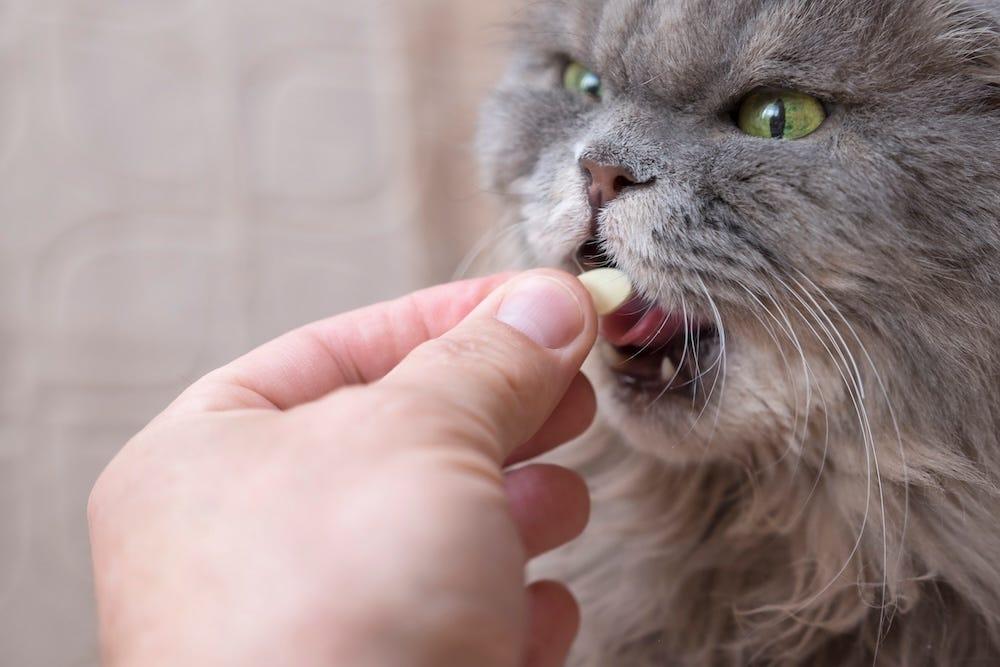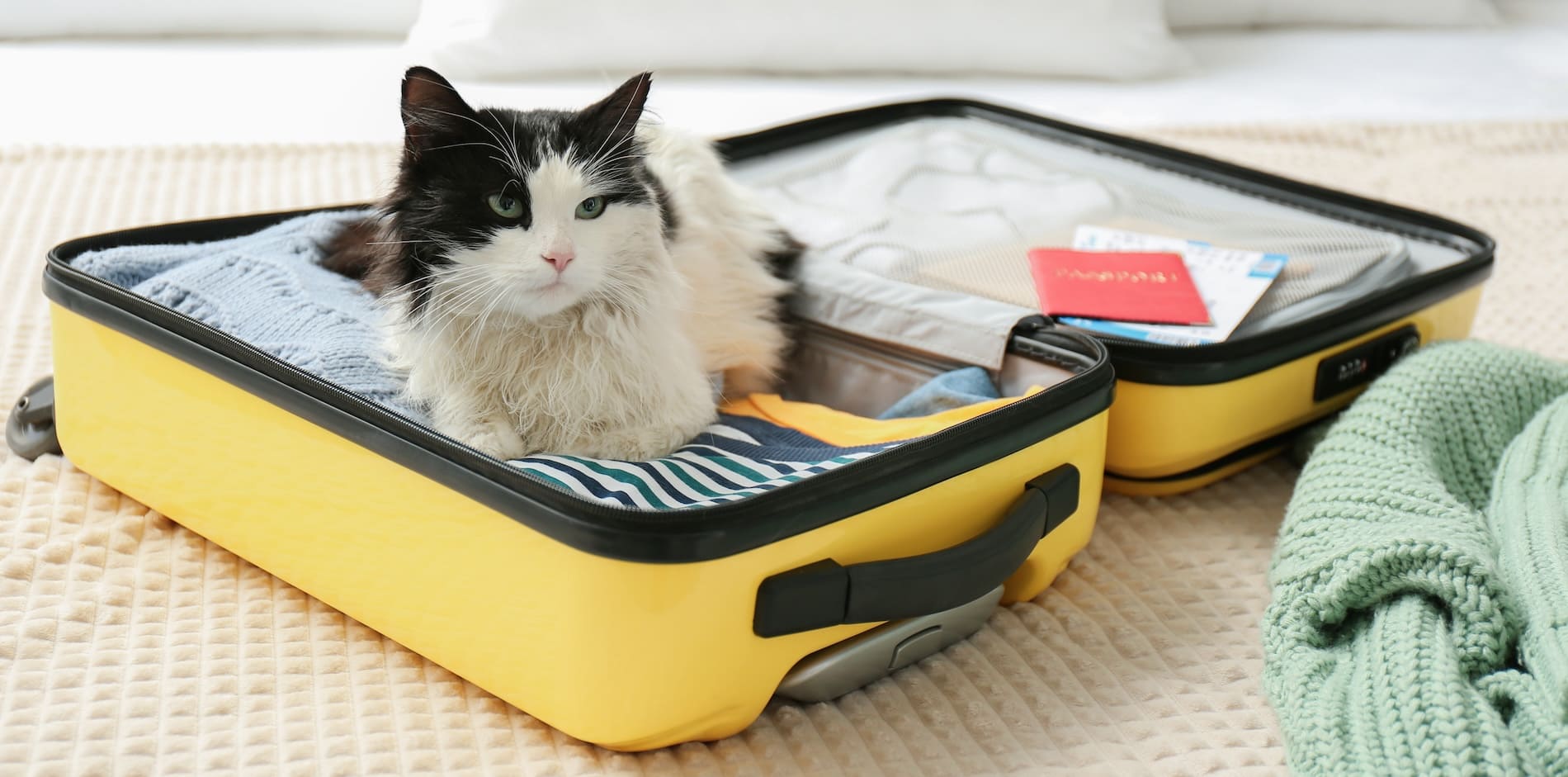We’re all familiar with allergies and the discomfort that can go along with them. One of the most common medications people tend to use is Benadryl. Believe it or not, our cats can experience allergies as well. So the question is, can you give a cat Benadryl? Is it safe and what dosage should be used? Let’s explore this below.
Before giving your cat any medication, you should consult your veterinarian. While Benadryl may be a common medication, you should still verify with your vet that you are using it for the appropriate reason. If you can’t reach your vet or local animal hospital, call the ASPCA Animal Poison Control Center (888-426-4435).
What is Benadryl?
Benadryl is the brand name of a common antihistamine medication, a medication to help control allergic reactions. Another name for Benadryl, or the generic name, is diphenhydramine. It is sold over the counter at most pharmacies and grocery stores. Some veterinarian offices may also sell different forms of Benadryl.

How does Benadryl work?
When our bodies experience an allergic reaction, they release histamines. This can cause itching, swelling, and redness. Antihistamines work to block the release of histamines and, therefore, decrease the symptoms of a reaction. Most antihistamines will cause drowsiness as a side effect—so unless it is specifically labeled non-drowsy, be prepared for a tired kitty. Surprisingly, the drowsy effect is extremely variable from cat to cat and human to human.
Can you give cats Benadryl?
Yes, so long as the medication only has diphenhydramine as the active ingredient and is not combined with pain relievers, decongestants, Benadryl is generally safe to use on cats. With the right dosage, it can help control your cat's allergic reactions and other types of symptoms.
When to use Benadryl for cats
Benadryl for cats can be beneficial for several reasons. Some of the most common reasons you may want to use Benadryl for cats may include:
- Allergic skin reactions
- Vaccine reactions
- Bug bites or bee stings
- Nausea
- Mild sedative
If your vet says it is safe to give your cat Benadryl, just make sure that the medication you are giving only has diphenhydramine as the active ingredient—and is not combined with pain relievers, decongestants, etc.
Benadryl for cats dosage
A good question to ask yourself is "how much Benadryl can I give my cat"? You should always consult your vet before beginning any medication regimen.
However, recommended doses of Benadryl for cats are typically 1 mg per 1 pound, to be given every 8-12 hours as needed. The safest option is to always consult with your veterinarian before giving your feline family member an over-the-counter medication. Your veterinarian is uniquely qualified to give your dosage recommendations and frequency of the medication based on the symptoms for which you want to use it.
Consult your vet and use this interactive calculator to determine how much Benadryl you should give your cat.
Pill or liquid Benadryl?
There are two different options of over-the-counter Benadryl that you can give your cat. We’re most familiar with Benadryl tablets or pills. It’s important to note that most Benadryl tablets come in 25 mg doses. However, the tablets can be split in half (if your cat weighs approximately 12 pounds) or quartered (if your cat weighs less than 7 pounds). It can be helpful to place the pill in a treat or food to get your cat to swallow it.
Another option is liquid Benadryl. This may be the easier option to get your cat to take the full amount of medication. Liquid Benadryl can be given via syringe—however, it’s important to administer it gently and slowly to prevent your cat from choking. Figuring out the appropriate dose for liquid Benadryl can be a little more challenging, but the ease of administration for some more difficult-to-medicate cats makes it worth consulting with your vet.
Benadryl for cats side effects
Any time we introduce a new medication or substance to a cat, it is important to watch for side effects. Some possible side effects of Benadryl can include:
- Drowsiness/sleepiness
- Agitation
- Dry mouth
- Problems urinating
- Diarrhea
- Vomiting
It can take one to two hours before the effects of Benadryl present themselves in your cat. You should monitor your cat closely during this time. If you notice that your cat has a reaction to the medication, you should cease administration of Benadryl until you speak with your veterinarian.
Can you give a cat Benadryl for anxiety?
While anti-anxiety effects can be one of the benefits of Benadryl, this effect isn’t typically strong nor is it usually the reason a veterinarian would recommend trying the medication. Instead of Benadryl, you should talk to your veterinarian about better anti-anxiety options.
One option that is a safe prescription medication is gabapentin: it works very well for short-term anxiety relief in cats. A good example of when to use this type of medication for anxiety in your cat would be when traveling by car or plane, especially if your cat has shown previous signs of anxiety when traveling. However, you should not rely on gabapentin or Benadryl to treat all instances of anxiety.
Sometimes your cat may just require a different outlet to help ease their anxiety. For example, you could try using catnip, which can be calming for some cats. You could also try encouraging play to help your cat expend extra energy. This rechargeable laser pointer may be a great option.
Can you give cats Benadryl for allergies?
Knowing that Benadryl is used primarily to treat allergies and allergic reactions in humans, you may be wondering if you can give a cat Benadryl for allergies. The general consensus is that Benadryl is safe to give your cat when given in the proper dose. If you notice your cat scratching themselves often or having a new reaction, consult your veterinarian and you should be able to give your cat Benadryl to treat their allergies.
Natural alternatives to Benadryl for cats
Benadryl may not be the answer for everyone. Many cat parents would prefer to use natural alternatives instead. Check out our post on herbs safe for cats if you’re looking for natural alternatives to treat your cat’s inflammation or allergies.
If Benadryl is not a good fit for your kitty and you are open to other over-the-counter medications, there are several other antihistamines that may have better effects for your feline friend. Work with your veterinarian to determine what medication or natural alternative is best for your cat.
Is Benadryl safe to give your cat?
The short answer is yes. Most veterinarians will agree that Benadryl is safe and effective to give to your cat if they are suffering from allergies or an allergic reaction. Again, you should always consult your vet before beginning any new medication regimens. You should also be sure to monitor your cat for any side effects, including vomiting and diarrhea.
If you find it hard to monitor your cat's waste patterns, you could try switching to a self-cleaning litter box like Litter-Robot 4. This, in combination with the Whisker app, can inform you of your cat’s waste patterns and weight and keep you notified as to when the waste drawer needs to be emptied. This can be helpful when starting a new medication and monitoring waste for any changes or side effects.
How do you give a cat a Benadryl pill?
First, be sure you are administering the right dosage—call your vet or local animal hospital to confirm. Then, try hiding the pill in a treat or food. Once your cat has ingested the pill, try gently rubbing their throat to encourage them to swallow while the pill is in their mouth.
How often can you give a cat Benadryl?
Typically, Benadryl is recommended every 8-12 hours, or two to three times per day. Always follow the directions given to you by your vet.
Sources:
- Diphenhydramine (Benadryl, Vetadryl, Banophen, Diphenhist)
- Can You Give Your Pets an Antihistamine?
- Diphenhydramine
Cover photo by Nick Karvounis on Unsplash








